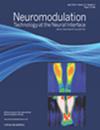Fluoroscopy-Guided Percutaneous Placement of Peripheral Nerve Stimulator of the Cervical Medial Branches in Patients With Treatment-Refractory Occipital Neuralgia: A Case Series
IF 3.2
3区 医学
Q2 CLINICAL NEUROLOGY
引用次数: 0
Abstract
Background
Pain from occipital neuralgia (ON) stems from the compression of the greater occipital nerve, muscle hypertrophy, or spasm. C2–C3 facet joint pain also is implicated in ON, given the third occipital nerve’s innervation of the C2–C3 zygapophysial joint. Percutaneous peripheral nerve stimulation (PNS) has in recent years been popularized as a minimally invasive approach in the management of treatment-resistant ON.
Objective
The study seeks to summarize the various modalities used in percutaneous peripheral nerve stimulator placement for ON in the existing literature and propose a novel fluoroscopic technique for effective peripheral nerve stimulator implantation established through a retrospective institutional case series for treatment of patients with ON.
Materials and Methods
MEDLINE was accessed for our literature search, and the time frame of the search was set from data base inception to May 1, 2024. Our institutional retrospective chart review was performed in patients who had undergone new implantation of the SPRINT PNS system (SPR Therapeutics, Inc, Cleveland, OH) from January 2023 to May 2024. Parameters extracted from patients’ charts for analysis included patient demographics, pain presentation, prior treatments and injection-based interventions, pain intensity, and opioid medications used.
Results
A total of five articles meeting the inclusion criteria were obtained after screening a total of 74 studies, describing peripheral nerve stimulator placement techniques using ultrasound, fluoroscopy, and a combination of both. Five institutional subjects were assessed in our case series. During active PNS therapy, there was a clinically significant reduction in pain (≥50%) intensity as measured by visual analog scale (VAS) score in all five subjects (N = 5, mean 7.20 vs 1.68, 95% CI [−8.87, −2.17], p = 0.0102). At 60 days, pain relief improved (N = 5, mean 7.20 vs 1.32, 95% CI [−8.97, −2.78], p = 0.0062). After device removal, the VAS score trended lower without attaining significance (n = 4, mean 7.5 vs 3.13, 95% CI [−11.04, 2.29], p = 0.128).
Conclusions
Our fluoroscopic-guided peripheral nerve stimulator placement technique yielded pain relief from therapeutic commencement to up to 18 weeks from device placement, exhibiting an efficacy equivalent to that of existing modalities of lead placement published in literature.
透视引导下经皮置入颈内支周围神经刺激器治疗难治性枕神经痛:一个病例系列。
背景:枕神经痛(ON)引起的疼痛源于枕大神经受压、肌肉肥大或痉挛。C2-C3关节突关节疼痛也与ON有关,因为第三枕神经支配着C2-C3关节突。近年来,经皮周围神经刺激(PNS)作为一种微创方法在治疗难治性ON中得到了推广。目的:本研究旨在总结现有文献中用于经皮周围神经刺激器植入治疗ON的各种方法,并通过回顾性机构病例系列,提出一种新的透视技术,用于有效植入周围神经刺激器。材料和方法:我们使用MEDLINE进行文献检索,检索时间范围从数据库建立到2024年5月1日。我们对2023年1月至2024年5月期间新植入SPRINT PNS系统(SPR Therapeutics, Inc, Cleveland, OH)的患者进行了机构回顾性图表回顾。从患者图表中提取用于分析的参数包括患者人口统计学、疼痛表现、既往治疗和注射干预、疼痛强度和使用的阿片类药物。结果:在对74项研究进行筛选后,共有5篇文章符合纳入标准,这些研究描述了使用超声、透视或两者结合的周围神经刺激器放置技术。在我们的病例系列中评估了五个机构受试者。在积极的PNS治疗期间,所有5名受试者的视觉模拟评分(VAS)测量的疼痛强度均有临床显著降低(≥50%)(N = 5,平均7.20 vs 1.68, 95% CI [-8.87, -2.17], p = 0.0102)。在60天,疼痛缓解得到改善(N = 5,平均7.20 vs 1.32, 95% CI [-8.97, -2.78], p = 0.0062)。移除器械后,VAS评分呈下降趋势,但未达到显著性(n = 4,平均值7.5 vs 3.13, 95% CI [-11.04, 2.29], p = 0.128)。结论:我们的透视引导下的周围神经刺激器放置技术从治疗开始到放置装置后的18周内都能缓解疼痛,其疗效与文献中发表的现有铅放置方式相当。
本文章由计算机程序翻译,如有差异,请以英文原文为准。
求助全文
约1分钟内获得全文
求助全文
来源期刊

Neuromodulation
医学-临床神经学
CiteScore
6.40
自引率
3.60%
发文量
978
审稿时长
54 days
期刊介绍:
Neuromodulation: Technology at the Neural Interface is the preeminent journal in the area of neuromodulation, providing our readership with the state of the art clinical, translational, and basic science research in the field. For clinicians, engineers, scientists and members of the biotechnology industry alike, Neuromodulation provides timely and rigorously peer-reviewed articles on the technology, science, and clinical application of devices that interface with the nervous system to treat disease and improve function.
 求助内容:
求助内容: 应助结果提醒方式:
应助结果提醒方式:


